


The French composer Hector Berlioz was a leading figure in the Romantic Movement. His work was full of his own thoughts and feelings, inspired by events from literature, and packed with novel ideas. Many of his works, like him, were on a larger than life scale -
HECTOR BERLIOZ 1803 -
Acknowledgements
Berlioz: by the French artist Émile Signol (1804-
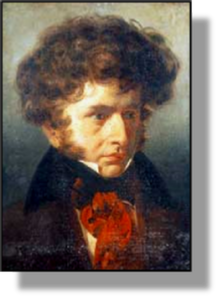
xxxxxThe French composer Hector Berlioz, along with Franz Liszt and Richard Wagner, was one of the foremost figures of the romantic era. Ever determined to go his own way, he used his music to express his own thoughts and feelings, and, for the most part, found his inspiration in dramatic events and locations featured in literature. And like the man himself, his music was full of emotion, bursting with energy, and packed with new ideas, seen at its best in his famous Symphonie fantastique of 1830, his Roméo and Juliette of 1839, and his cantatas The Damnation of Faust, in 1846, and the Infant Christ, completed in 1854. And to these must be added his three operatic works, Benvenuto Cellini of 1838, The Trojans of 1858, and Béatrice and Bénédict, produced in 1862. (As a young man he was known as “Mad Hector with the Flaming Locks”).
xxxxxBut Berlioz was an outstanding conductor as well as a brilliant composer, and these skills combined to make him the founder of modern orchestration. His knowledge and understanding of the increasing range of individual instruments enabled him to produce and direct orchestrated compositions on a large, imposing scale. These were not always appreciated in their day, particularly in France, but the musical innovations they introduced helped to increase the expressive role of the orchestra, and his Treatise on Modern Instrumentation of 1843, the first book of its kind, played an important part in the development of 19th century music in general.
xxxxxBerlioz was born at La Côte-
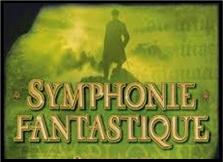
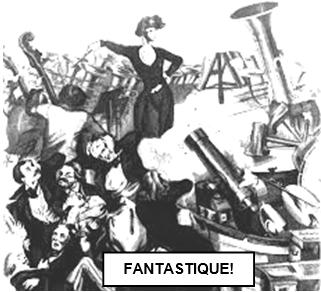 xxxxxThis work, fantastic in every sense of the word, was a piece of programmed music, the first of its kind, which traced the episodes in the life of a love-
xxxxxThis work, fantastic in every sense of the word, was a piece of programmed music, the first of its kind, which traced the episodes in the life of a love-
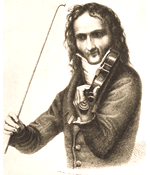 xxxxxBerlioz spent two years in Italy and during his stay composed the overtures The Corsair and King Lear. It was while in Rome that he met the Russian composer Mikhail Glinka, and made a life-
xxxxxBerlioz spent two years in Italy and during his stay composed the overtures The Corsair and King Lear. It was while in Rome that he met the Russian composer Mikhail Glinka, and made a life- limited role. Nevertheless, the virtuoso violinist was greatly impressed when he heard the composition in 1838. He declared Berlioz a genius, and the following day sent him 20,000 francs. This generous gift enabled him to spend time composing Roméo and Juliette -
limited role. Nevertheless, the virtuoso violinist was greatly impressed when he heard the composition in 1838. He declared Berlioz a genius, and the following day sent him 20,000 francs. This generous gift enabled him to spend time composing Roméo and Juliette -
xxxxxBerlioz and Harriet separated in 1842, and it was in that year that he embarked on a series of long concert tours abroad, often traveling with his new lady friend, the singer Marie Recio, whom he married in 1854. These trips took him to Germany, Vienna, Prague, Budapest, Russia and London, where he conducted his own works, and gained recognition both as an innovative composer and a new-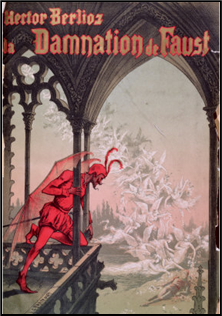 l, and two highly ambitious works, his dramatic cantata The Damnation of Faust, premiered in 1846, and his colossal Te Deum of 1850. But these works, conceived on a spectacular scale, failed to attract the concert-
l, and two highly ambitious works, his dramatic cantata The Damnation of Faust, premiered in 1846, and his colossal Te Deum of 1850. But these works, conceived on a spectacular scale, failed to attract the concert-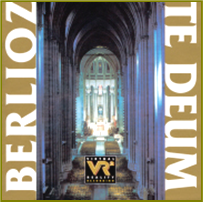 ly attended and harshly criticised, and his Te Deum -
ly attended and harshly criticised, and his Te Deum -
xxxxxHe completed his third opera, Béatrice and Bénédict in 1862. It was to be his last composition. Marie died in that year, and he himself, embittered by the lack of public interest in his work, began to suffer from depression and ill health. The death of his son Louis in 1867 deeply distressed him and, following a conducting tour in Russia, he died in Paris in March 1869.
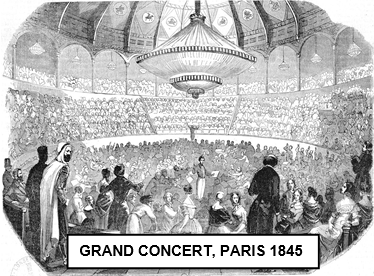 xxxxxThe Symphonie fantastique remains Berlioz’ best known work, but over the years his operas and other grand compositions, denounced in his day, have added to his stature as a composer and orchestrator. In his choice of themes he was especially inspired by the works of Shakespeare, whilst in his music he was indebted to Ludwig van Beethoven for his development of programme music. And he learnt new concepts of form and harmony, and probably the idea of a recurring theme, from his friend Franz Listz. For his part, numerous composers, including Charles Gounod, Richard Wagner and Richard Strauss, were inspired and influenced by his powerful, unorthodox music, and the boost he gave to the growth and flair of the Romantic orchestra. Indeed, the modern orchestra was effectively created by Berlioz, and he himself paved the way for the maestros of the next century.
xxxxxThe Symphonie fantastique remains Berlioz’ best known work, but over the years his operas and other grand compositions, denounced in his day, have added to his stature as a composer and orchestrator. In his choice of themes he was especially inspired by the works of Shakespeare, whilst in his music he was indebted to Ludwig van Beethoven for his development of programme music. And he learnt new concepts of form and harmony, and probably the idea of a recurring theme, from his friend Franz Listz. For his part, numerous composers, including Charles Gounod, Richard Wagner and Richard Strauss, were inspired and influenced by his powerful, unorthodox music, and the boost he gave to the growth and flair of the Romantic orchestra. Indeed, the modern orchestra was effectively created by Berlioz, and he himself paved the way for the maestros of the next century.
xxxxxIncidentally, we are told that when he began studying at the school of medicine in Paris -
xxxxx…… The term “fixed idea”, which Berlioz used to describe his idea of a recurring musical theme, was actually a medical term referring to a stubbornly held belief that cannot be changed by reason. He would have learnt about this when he was studying medicine. ……
xxxxx…… The Symphonie fantastique owed much to Beethoven. In his Pastoral Symphony the German composer had used each of the five movements to describe a particular emotion. Building upon this idea, Berlioz produced a piece of programme music which told a story by a series of scenes, in much the same way as in a theatre production.
Including:
Robert Schumann

xxxxxLike Hector Berlioz, the German composer Robert Schumann (1810-
Va-
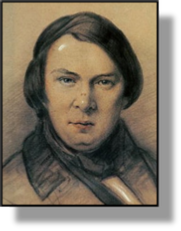 xxxxxThe German composer Robert Schumann (1810-
xxxxxThe German composer Robert Schumann (1810-
xxxxxSchumann was born in Zwickau, Saxony. He began piano lessons when he was six and, as the son of a bookseller, acquired an interest in literature from an early age. As a boy he composed a number of songs and played at school concerts and music soirées, but despite the promise he then showed, his parents had earmarked him for the legal profession. After the death of his father in 1826 he reluctantly attended the universities of Leipzig and Heidelberg, but he showed no interest in his law studies and, after attending a concert by the great violin virtuoso Paganini, determined to become a musician. In 1830, with his mother’s blessing, he abandoned his law course and returned to Leipzig to study under a well- virtuoso pianist. As a result, he spent more time on composing, and also took up a career as a working journalist. In 1834 and for the next ten years he edited his own highly influential journal, the Neue Zeitschrift für Musik (The New Musical Magazine) and gained a well-
virtuoso pianist. As a result, he spent more time on composing, and also took up a career as a working journalist. In 1834 and for the next ten years he edited his own highly influential journal, the Neue Zeitschrift für Musik (The New Musical Magazine) and gained a well-
xxxxxDuring the 1830s Schumann gave much of his time over to the composition of short piano pieces. These delightful musical expressions, based on literary themes or exploring his own inner feelings and memories, proved to be among his most enduring works. They included Carnival, Butterflies, Arabesque, Scenes from Childhood, Kreisleriana and a set of variations entitled Symphonic Studies. Then in 1840, after years of bitter opposition from his former teacher Friedrich 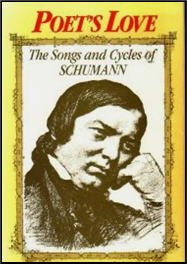 Wieck -
Wieck -
xxxxxThe 1840s saw the production of his first and second symphonies, his String Quartets and Piano Quintet, and his incidental music to Byron’s verse drama Manfred. It was during this period, however, that the stress of constant work began to take its toll, and he suffered a serious recurrence of the bouts of depression that had plagued him since his youth. He was appointed to the staff of the newly- e managed in that year to produce one of his finest orchestral pieces, his famous “Rhenish” 3rd Symphony, but after this his mental state deteriorated rapidly. In February 1854 he attempted suicide by throwing himself into the Rhine, and then finished his days in a private asylum at Endenich, aged 46. It was a tragic ending for a musician of such promise whose music, often so full of joy and serenity, has survived the test of time.
e managed in that year to produce one of his finest orchestral pieces, his famous “Rhenish” 3rd Symphony, but after this his mental state deteriorated rapidly. In February 1854 he attempted suicide by throwing himself into the Rhine, and then finished his days in a private asylum at Endenich, aged 46. It was a tragic ending for a musician of such promise whose music, often so full of joy and serenity, has survived the test of time.
xxxxxThe variety and the range of Schumann’s compositions are remarkable, as is the number of works he produced in a career that was so tragically short and so often troubled. As a true romantic, his work is of a highly personal nature, be it in his interpretation of a particular poem or drama, or in the outpourings of his own thoughts and feelings, often triggered by his memories of childhood, his delight in nature, and his love for Clara.
xxxxxHis orchestral work and chamber music have passages of rare beauty, grandeur and joyfulness, to be seen in his “Spring” Symphony, for example, his Piano Concerto in A minor, and his Paradise and the Peri of 1843. Essentially, however, Schumann was not fully at home in composing large scale works for the concert hall. It was in his songs and piano pieces, rounded and concise, that his intimate thoughts and dreams could be appreciated in their purest and most concentrated form, and it is in that form that he excelled. And two musicians who did much to make his music known across Europe was his close friend Felix Mendelssohn, and the German composer and pianist Johannes Brahms, who supported his family after his death.
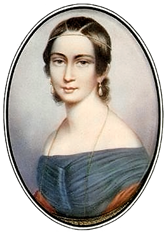
xxxxxIncidentally, Schumann’s wife Clara (née Wieck) (1819-
xxxxx…… Uncertainty still remains as to how Schumann hurt one of his fingers on his right hand, thereby ending his hopes of becoming a concert pianist. The general explanation is that the damage was done while he was using a gadget he had devised to strengthen his fingers. His wife, however, blamed a stiff dummy keyboard that he used to practise on, and Schumann himself very seldom referred to the accident. He put it down to “too much writing”, but, in fact, it might have been caused by the mercury he was taking to treat syphilis. ……
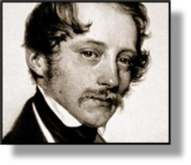 xxxxxAnotherxGerman composer who deserves mention here is Otto Nicolai (1810-
xxxxxAnotherxGerman composer who deserves mention here is Otto Nicolai (1810- became the first conductor of the Vienna Philharmonic Orchestra in 1841. He died from a stroke at the age of 39, just two months after the premiere of his famous opera, and just two days after his appointment as director of the Berlin State Opera. On the day of his death he was elected a member of the Royal Prussian Academy of Arts.
became the first conductor of the Vienna Philharmonic Orchestra in 1841. He died from a stroke at the age of 39, just two months after the premiere of his famous opera, and just two days after his appointment as director of the Berlin State Opera. On the day of his death he was elected a member of the Royal Prussian Academy of Arts.


